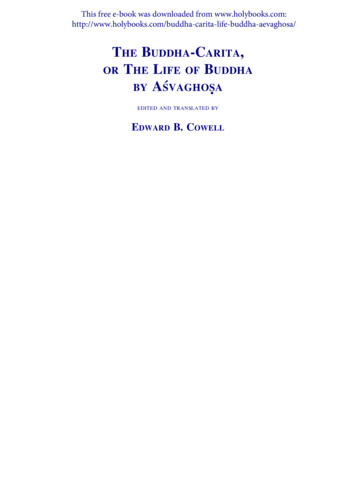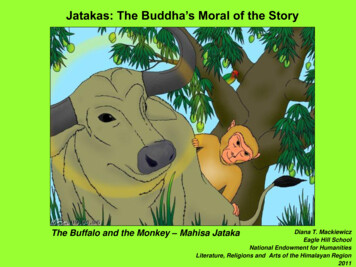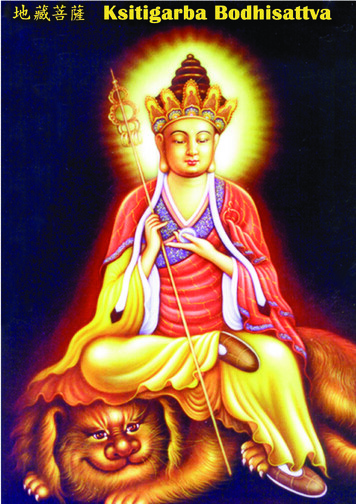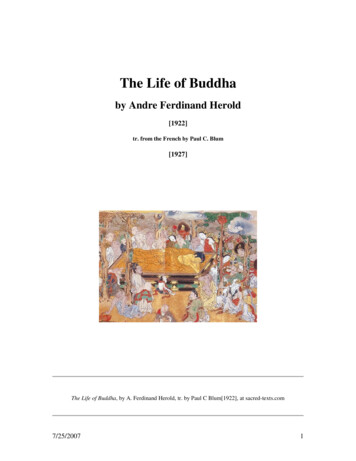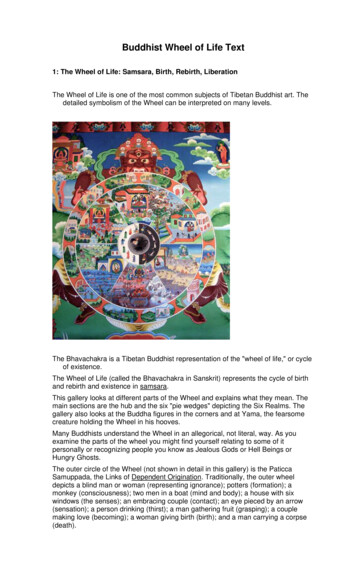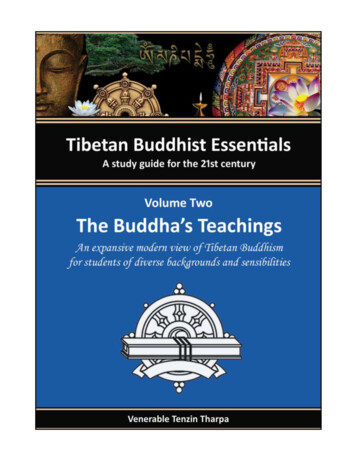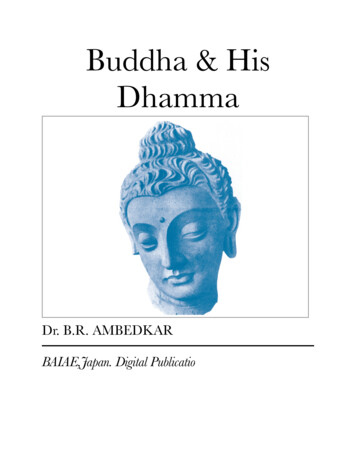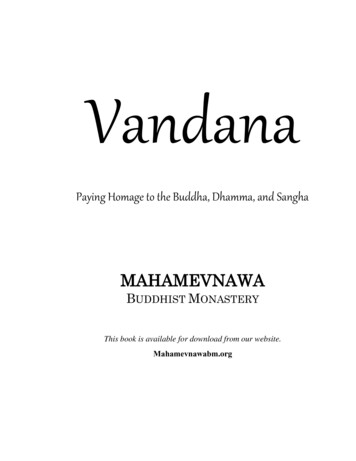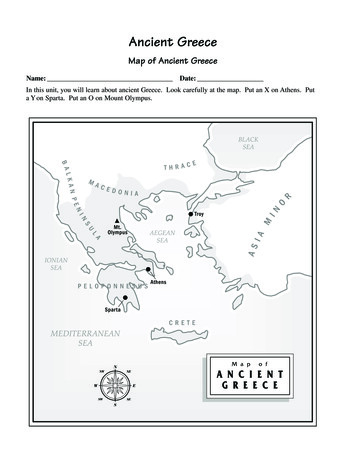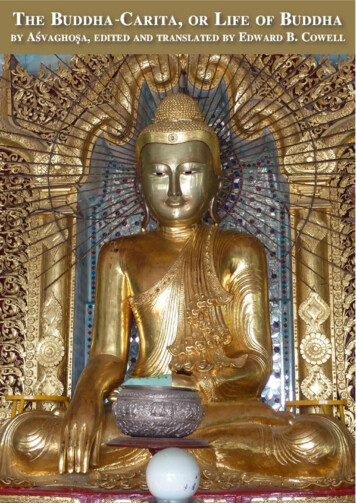
Transcription
The Buddha-Carita,or The Life of Buddhaby Aśvaghoṣaedited and translated byEdward B. Cowell
Table of Contents (detail)PrefaceIntroductionBook I: [Bhagavatprasūtiḥ]Book II: [Antaḥpuravihāro]Book III: [Sa!vegotpattiḥ]Book IV: [Strīvighātano]Book V: [Abhiniṣkramaṇo]Book VI: [Cha!dakanivartana!]Book VII: [Tapovanapraveśo]Book VIII: [A!taḥpuravilāpo]Book IX: [Kumārānveṣaṇo]Book X: [Śreṇyābhigamano]Book XI: [Kāmavigarhaṇo]Book XII: [Arāḍadarśano]Book XIII: [Māravijayo]Book XIV
PrefaceThe text and translation of Buddhacarita presented here is for the most part thatprinted in The Buddhacarita or Life of Buddha by Aśvaghoṣa, which was edited andtranslated by Professor Edward B. Cowell (first published in 1894 [text] & 1895[translation], reprinted together New Delhi, 1977). The readings and translation havebeen supplemented by E.H. Johnson’s text and translation entitled Aśvaghoṣa’sBuddhacarita or Acts of the Buddha (first published in Lahore, 1936; reprinted Delhi,1995).The Sanskrit text has been made from a database prepared by Peter Schreiner inFebruary 1990, which contained the pausa form of both Cowell’s and Johnson’s textsin ASCII format, which I have converted to normal diacritics (the diactrical systememployed is described below). I hope at a later date to prepare a text with the pausaform analysis included, which will be a help to students studying the text.The text and translation presented here represents the first fourteen chapters ofAśvaghoṣa’s text, with the beginning supplemented by the spurious verses found at thebeginning of Cowell’s edition (presumably by AmItānanda), and Johnson’s translation(only) from the Tibetan and Chinese sources to round off Chapter Fourteen. Majordiscrepencies between the two editions have been noted and occasionallysupplementary material from Johnson’s edition has been included.I have entered Cowell’s notes to the translation, as they often provide interesting crossreferences, and I have also prepared his Introduction to the translation of the text. Ihave not entered his notes to the text though, as I hope at a later date to be able tomake a full comparison with Johnson’s edition.The text itself has been presented with a metrical analysis elsewhere on this website,and an English only version of the translation, which contains the translation ofAmItānanda’s supplementary text, which was printed in the Editio Princeps, but whichis omitted here as it throws no light on Aśvaghoṣa’s original work.The system of transliteration of Eastern scripts that was used in the Sacred Books ofthe East was later felt to have a number of disadvantages to it, and went out of fashionafter the series was completed. Therefore in preparing this book for electronicpublication I have taken the opportunity to update the presentation in this regard to astandard which is most commonly in use, and is in agreement with the other texts usedon this website.Ānandajoti BhikkhuAugust 2005
4IntroductionThe Sanskrit text of the Buddha-carita was published at the beginning of last year [i.e1893] in the ‘Anecdota Oxoniensia,’ and the following English translation is nowincluded in the series ‘Sacred Books of the East.’ It is an early Sanskrit poem writtenin India on the legendary history of Buddha, and therefore contains much that is ofinterest for the history of Buddhism, besides its special importance as illustarating theearly history of classical Sanskrit literature.It is ascribed to Aśvaghoṣa; and although there were several writers who bore thatname, it seems most probable that our author was the contemparary and spiritualadvisor of Kaniṣka in the first century of our era. Hiouen Thsang, who left India in A.D. 645, mentions him with Deva, Nāgārjuna, and Kumāralabdha, ‘as the four sunswhich illumine the world;’1 but our fullest account is given by I-tsing, who visitedIndia in 673. He states that Aśvaghoṣa was an ancient author who composed theAlaOkāra-śāstra and the Buddha-carita-kāvya, — the latter work being of course thepresent poem. Besides these two works he also composed the hymns in honour ofBuddha and the three holy beings Amitābha, Avalokiteśvara, and Mahāsthāma, whichwere chanted at the evening service of the monasteries. ‘In the five countries of Indiaand in the countries of the Southern ocean they recite these poems, because theyexpress a store of ideas and meaning in a few words.’2 A solitary stanza (VIII, 13) isquoted from the Buddha-carita in Rāyamukuṭa’s commentary on the Amarakoṣa I, i. 1,2, and also by Ujjvaladatta in his commentary on the Uṇādi-sūtras I, 156; and fivestanzas are quoted as from Aśvaghoṣa in Vallabhadeva’s Subhāṣitāvali, which bear agreat resemblance to his style, though they are not found in the extant portion of thispoem.3The Buddha-carita was translated into Chinese4 by Dharmarakṣa in the fifth century,and a translation of this was published by the Rev. S. Beal in the present series [of theSacred Books of the East]; it was also translated into Tibetan in the seventh or eighthcentury. The Tibetan as well as the Chinese version consists of twenty-eighth chapters,and carries down the life of Buddha to his entrance into Nirvāṇa and the subsequentdivision of the sacred relics. The Tibetan version appears to be much closer to theoriginal Sanskrit than the Chinese; in fact from its verbal accuracy we can oftenreproduce the exact words of the original, since certain Sanskrit words are alwaysrepresented by the same Tibetan equivalents, as for instance, the prepositions prefixedto verbal roots. I may here express an earnest hope that we may ere long have anedition and translation of the Tibetan version, if some scholar can be found tocomplete Dr. Wendzel’s unfinished labour. He had devoted much time and thought tothe work; I consulted him in several of my difficulties, and it is from him that Iderived all my information about the Tibetan renderings. This Tibetan version1Julien’s translation, vol ii, p. 214.See M. Fujishama, Journal Asiatique, 1888, p. 425.3Professor Peterson has remarked that two stanzas out of the five occur in BhartIhari’s Nītiśataka.4We have for the present classed the Buddha-carita with the Mahāyāna Sūtras in default ofmore exact information.2
5promises to be of great help in restoring the many corrupt readings which still remainin our faulty Nepalese MSS.Only thriteen books of the Sanskrit poem claim to be Aśvaghoṣa’s composition; thelast four books are an attempt by a modern Nepalese author to supply the loss of theoriginal. He tells us this honestly in the colophon, — ‘having searched for themeverywhere and not found them, four cantos have been made by me, AmItānanda, —the fourteenth, fifteenth, sixteenth, and seventeenth.’ He adds the date 950 of theNepalese era, corresponding to 1830 a. d.; and we have no difficulty in idendifying theauthor. Rājendralāl Mitra in his ‘Nepalese Buddhist Literature’ mentions AmItānandaas the author of two Sanskrit treatises and one in Newārī; he was probably the fatherof the old paṇḍit of the Residency at Kāṭmāṇḍu, Guṇananda, whose son Indrānandaholds the office at present. Dr. D. Wright informs me that the family seem to havebeen the recognised historians of the country, and keepers of the MS. treasures ofsundray temples. The four books are included in this translation as an interestingliterary curiosity. The first portion of the fourteenth book agrees partly with theTibetan and Chinese, and AmItānanda may have had access to some imperfect copy ofthis portion of the original; but after that his account is quite independent, and has norelation to the two versions.In my preface to the edition of the Sanskrit text I have tried to show that Aśvaghoṣa’spoem appears to have exercised an important influence on the succeeding poets of theclassical period in India. When we compare the descriptions in the seventh book of theRaghuva!sa of the ladies of the city crowding to see prince Aja as he passes by fromthe Svaya!vara where the princess Bhojyā has chosen him as her husband, with theepisode in the third book of the Buddha-carita (ślokas 13-24); or the description’s ofKāma’s assault on Śiva in the Kumārasambhava with that of Māra’s temptation ofBuddha in the thirteenth book, we can hardly fail to trace some connection. There is asimilar resemblance between the description in the fifth book of the Rāmāyaṇa, wherethe monkey Hanumat enters Rāvaṇa’s palace by night, and sees his wives asleep in theseraglio and their various unconscious attitudes, and in the description in the fifthbook of the present poem where Buddha on the night of his leaving his home for eversees the same unconscious sight in his own palace. Nor may we forget that in theRāmāyaṇa the description is introduced as an ornamental episode; in the Buddhistpoem it an essential elelment in the story, as it supplies the final impulse which stirsthe Bodhisattva to make his escape from the world. These different descriptionsbecame afterwards commonplaces in Sanskrit poetry, like the catalogue of the ships inGreek or Roman epics; but they may very well have originated in connection withdefinite incidents in the Buddhist sacred legend.The Sanskrit MSS. of Nepal are always negligently transcribed and abound withcorrupt passages, which it is often very difficult to detect and restore. My printed textleaves many obscure lines which will have to be cleared up hereafter by more skilfulemendations. I have given in the notes to the translation some further emendations ofmy own, and I have also added several happy conjectures which continental scholars
6have kindly suggested to me by letter; and I gladly take this opportunity of adding in a1foot-note some of which I received too late to insert in their proper places.I have endeavoured to make my translation intelligible to the English reader, butmany of the verses in the original are very obscure. Aśvaghoṣa employs all theresources of Hindu rhetoric (as we might well expect if I-tsing is right in ascribing tohim an ‘alaOkāra-śāstra’), and it is often difficult to follow his subtil turns of thoughtand remote allusions; but many passages no doubt owe their present obscurity toundetected mistakes in the text of our MSS. In the absence of any commentary (exceptso far as the diffuse Chinese translation and occasional reference to the Tibetan havesupplied the want) I have necessarily been left to my own resources, and I cannot failto have sometimes missed my author’s meaning.Prā%śulabhye phale mohād udbāhur iva vāmanaḥ;but I have tried to do my best, and no one will welcome more cordially any lightwhich others may throw on the passages I have misunderstood.The edition of the original text was dedicated to my old friend Professor F. MaxMüller, and it is sincere gratification to me that this translation will appear in thesame volume with similar translations from his pen.E. B. C.Cambridge:Feb 1, 1894.1Dr. von Boehtlingk suggests ‘saujā vicacāra’ in VIII, 3, and ‘vilambakeśyo’ in VIII, 21, — twocertain emendations. Professor Kielhorn would read ‘nabhasy eva’ in XIII, 47 for ‘nayaty eva,’and ‘tatraiva nāsīnam ṣim’ in XIII, 50. Professor Bühler would read ‘priyatanayas tanayasya’in I, 87, and ‘na tatyāja ca’ in IV, 80.
7Book I: [Bhagavatprasūtiḥ][The Birth of the Holy One]1śriya% parārdhyā% vidadhadvidhāt1jit tamo nirasyannabhibhūtabhānubh1t nudannidāgha% jitacāruca%dramāḥ sa va%dyate ’rhanniha yasya nopamā 1.1*21. That Arhat is here saluted, who has no counterpart, — who, as bestowing thesupreme happiness, surpasses (Brahman) the Creator, — who, as driving awaydarkness, vanquishes the sun, — and, as dispelling all burning heat, surpasses thebeautiful moon.āsīdviśālonnatasānulakṣmyā payodapa%ktyeva parītapārśvam udagradhiṣṇya% gagaṇe ’vagāḍha% pura% maharṣeḥ kapilasya vastu 1.2*2. There was a city, the dwelling-place3 of the great saint Kapila, having its sidessurrounded by the beauty of a lofty broad table-land as by a line of clouds, and itself,with its high-soaring palaces,4 immersed in the sky.sitonnateneva nayena h1tvā kailāsaśailasya yadabhraśobhām bhramādupetān vahada%buvāhān sa%bhāvanā% vā saphalīcakāra 1.3*3. By its pure and lofty system of government it, as it were, stole the splendour of theclouds of Mount Kailāsa, and while it bore the clouds which came to it through amistake, it fulfilled the imagination which had led them thither.5ratnaprabhodbhāsini yatra lebhe tamo na dāridryamivāvakāśam parārdhyapauraiḥ sahavāsatoṣāt k1tasmitevātirarāja lakṣmīḥ 1.4*4. In that city, shining with the splendour of gems, darkness like poverty could find noplace; prosperity shone resplendently, as with a smile, from the joy of dwelling withsuch surpassingly excellent hāna% prativeśama śobhām jagatyad1ṣṭveva samānamanyatspardhā% svagehairmitha eva cakre 1.5*5. With its festive arbours, its arched gateways and pinnacles,6 it was radiant withjewels in every dwelling; and unable to find any other rival in the world, it could onlyfeel emulation with its own houses.1The chapter titles are not given by Cowell, and are taken from Johnston’s version. There is nohead-title in the original, but they can be inferred from the end-title.2Verses marked with an asterick are omitted from Johnson’s edition as being spurious.3Vastu seems to be used here for vāstu.4Dhiṣṇya5They had though that it was Kailāsa6Or towers? (si hakarṇaiḥ)
Buddha-carita, or The Life of Buddha - 8rāmāmukhe%dūn paribhūtapadmān yatrāpayāto ’pyavimanya bhānuḥ sa%tāpayogādiva vāri veṣṭu% paścātsamudrābhimukhaḥ pratasthe 1.6*6. There the sun, even although he had retired, was unable to scorn the moon-likefaces of its women which put the lotuses to shame, and as if from the access ofpassion, hurried towards the western ocean to enter the (cooling) water.śakyārjitānā% yaśasā% janena d1ṣṭvā%tabhāva% gamito ’yamindraḥ iti amivodayacchat 1.7*7. ‘Yonder Indra has been utterly annihilated by the people when they saw the gloriesacquired by the Sakyas,’-uttering this scoff, the city strove by its banners with gayfluttering streamers to wipe away every mark of his existence.1k1tvāpi rātrau kumudaprahāsami%doḥ karairyadrajatālayasthaiḥ sauvarṇaharmyeṣu gatārkapādairdivā sarojadyutimālala%be 1.8*8. After mocking the water-lilies even at night by the moonbeams which rest on itssilver pavilions, — by day it assumed the brightness of the lotuses through thesunbeams falling on its golden palaces.mahīb1tā% mūrdhni k1tābhiṣekaḥ śuddhodano nāma n1po ’rkaba%dhuḥ adhyāśayo vā sphuṭapudarīka% purādhirāja% tadala%cakāra 1.9*9. A king, by name Śuddhodana, of the kindred of the sun, anointed to stand at thehead of earths monarchs, — ruling over the city, adorned it, as a bee-inmate a fullblown lotus.2bhūbh1tparārdhyo ’pi sapakṣa eva prav1ttadāno ’pi madānupetaḥ īśo ’pi nitya% samaḍ1ṣṭipātaḥ saumyasvabhāvo ’pi p1thupratāpaḥ 1.10*10. The very best of kings with his train ever near him,3 — intent on liberality yetdevoid of pride;4 a sovereign, yet with an ever equal eye thrown on all,5 — of gentlenature and yet with wide-reaching majesty.61For the genitive yaśasām, see Pāṇ. II, 3. 52 (adhīgartha).Vā is used for iva in Śiśup. Badha, III, 63, IV, 35; Meghad. 82. (Cf. infra, IV, 44.)Purādhirājam seems used adverbally. Cf. the line in Vikramorv. kusumāny āśerate shaṭpadāḥ.Could it mean ‘as a thought the lotus of the heart?’3Also ‘though the highest of mountains, yet bearing his wings (uncut).’4Or if applied to an elephant, ‘not in rut.’5Or with a double meaning in īśa, ‘though like Śīva, yet with even eyes,’ i.e. not three.6Or ‘like the moon, yet widely burning (like the sun).’2
Buddha-carita, or The Life of Buddha - 9bhujena yasyābhihatāḥ pata%to dviṣaddvipe%drāḥ samarā%gaṇeṣu udvā%tamuktāprakaraiḥ śirobhirbhaktyeva puṣpā%jalibhiḥ praṇemuḥ 1.11*11. Falling smitten by his arm in the arena of battle, the lordly elephants of hisenemies bowed prostrate with their heads pouring forth quantities of pearls as if theywere offering handfuls of flowers in homage.atipratāpādavadhūya śatrūnmahoparāgāniva tigmabhānuḥ udyotayāmāsa jana% sama%tātpradarśayannāśrayaṇīyamārgān 1.12*12. Having dispersed his enemies by his preeminent majesty as the sun disperses thegloom of an eclipse, he illuminated his people on every side, showing them the pathswhich they were to follow.dharmārthakāmā viṣaya% mitho ’nya% na veśamācakramurasya nītyā vispardhamānā iva tūgrasiddheḥ sugocare dīptatarā babhūvuḥ 1.13*13. Duty, wealth, and pleasure under his guidance assumed mutually each other’sobject, but not the outward dress; yet as if they still vied together they shone all thebrighter in the glorious career of their triumphant success.udārasa%khyaiḥ sacivāirasa%khyaiḥ k1tāgrabhāvaḥ sa udagrabhāvaḥ śaśī yathā bhairak1tānyathābhaiḥ śakye%drarājaḥ sutarā% rarāja 1.14*14. He, the monarch of the Śākyas, of native pre-eminence, but whose actual preeminence was brought about by his numberless councillors of exalted wisdom, shoneforth all the more gloriously, like the moon amidst the stars shining with a light likeits own.1tasyātiśobhāvis1tātiśobhā raviprabhevāstatamaḥ prabhāvā samagradevīnivahāgradevī babhūva māyāpagateva māyā 1.15*15. To him there was a queen, named Māyā, as if free from all deceit (māyā) — aneffulgence proceeding from his effulgence, like the splendour of the sun when it isfree from all the influence of darkness, a chief queen in the united assembly of allqueens.prajāsu māteva hitaprav1ttā gurau jane bhaktirivānuv1ttā lakṣmīrivādhīśakule k1tābhā jagatyabhūduttamadevatā yā 1.16*16. Like a mother to her subjects, intent on their welfare, — devoted to all worthy ofreverence like devotion itself, — shining on her lord’s family like the goddess ofprosperity, — she was the most eminent of goddesses to the whole world.1Or perhaps ‘shining with its light undimmed by the stars.’
Buddha-carita, or The Life of Buddha - 10kāma% sadā strīcarita% tamisra% tathāpi tā% prapya bh1śa% vireje na hī%dulekhāmupagamya śubhā% nakta% tathā sa%tamasatvameti 1.17*17. Verily the life of women is always darkness, yet when it encountered her, it shonebrilliantly; thus the night does not retain its gloom, when it meets with the radiantcrescent of the moon.atī%driyenātmani duṣkuho ’ya% mayā jano yojayitu% na śakyaḥ itīva sūkṣmā% prak1ti% vihāya dharmeṇa sākṣādvihitā svamūrtiḥ 1.18*18. ‘This people, being hard to be roused to wonder in their souls, cannot be influencedby me if I come to them as beyond their senses,’ - so saying, Duty abandoned her ownsubtile nature and made her form visible.cyuto ’tha kāyāttuṣitāt trilokīmudyotayannuttamabodhisattvaḥ viveśa tasyāḥ sm1ta eva kukṣau na%dāguhāyāmiva nāgarājaḥ 1.19*19. Then falling from the host of beings in the Tuṣita heaven,1 and illumining thethree worlds, the most excellent of Bodhisattvas suddenly entered at a thought into herwomb, like the Nāga-king entering the cave of Nandā.dh1tvā himādridhavala% guru ṣaḍviṣāṇā%dānādhivāsitamukha% dviradasya rūpam śuddhodanasya vasudhādhipatermahiṣyāḥkukṣi% viveśa sa jagadvyasanakṣayāya 1.20*20. Assuming the form of a huge elephant white like Himālaya, armed with six tusks,with his face perfumed with flowing ichor, he entered the womb of the queen of kingŚuddhodana, to destroy the evils of the world.rakṣāvidhāna% prati lokapālā lokaikanāthasya divo ’bhijagmuḥ sarvatra bhā%to ’pi hi ca%drapādā bhaja%ti kailāsagirau viśeṣam 1.21*21. The guardians of the world hastened from heaven to mount watch over the world’sone true ruler; thus the moonbeams, though they shine everywhere, are especiallybright on Mount Kailāsa.mayāpi ta% kukṣigata% dadhānā vidyudvilāsa% jaladāvalīva dānābhivarṣaiḥ parito janānā% dāridryatāpa% śamayā%cakāra 1.22*22. Māyā also, holding him in her womb, like a line of clouds holding a lightningflash, relieved the people around her from the sufferings of poverty by rainingshowers of gifts.1For tuṣitāt kāyāt, cf. tuṣite devanikāya apapannā, Divyāvad. p. 82; and tuṣitakāyika, Lalitav.ṣaḍdanta.
Buddha-carita, or The Life of Buddha - 11sātaḥ purajanā devī kadācidatha lu%binīm jagāmānumate rājñaḥ sa%bhūtottamadohadā 1.23*23. Then one day by the king’s permission the queen, having a great longing in hermind, went with the inmates of the gynaeceum into the garden Lumbinī.śākhāmāla%bamānāyāḥ puṣpabhārāvala%binīm devyāḥ kukṣi% vibhidyāśu bodhisattvo viniryayau 1.24*24. As the queen supported herself by a bough which hung laden with a weight offlowers, the Bodhisattva suddenly came forth, cleaving open her womb.tataḥ prasannaśca babhūva puṣyastasyāśca devyā vratasa%sk1tāyāḥ pārśvātsuto lokahitāya jajñe nirvedana% caiva nirāmaya% ca 1.25 (1.9)125. At that time the constellation Puṣya was auspicious, and from the side of thequeen, who was purified by her vow, her son was born for the welfare of the world,without pain and without illness.prātaḥ payodādiva tigmabhānuḥ samudbhavanso ’pi ca māt1kukṣeḥ sphuranmayūkhairvihatā%dhakāraiścakāra loka% kanakāvadātam 1.26*26. Like the sun bursting from a cloud in the morning, — so he too, when he was bornfrom his mother’s womb, made the world bright like gold, bursting forth with his rayswhich dispelled the darkness.ta% jātamātramatha kā%canayūpagaura%prītaḥ sahasranayaṇaḥ śanakairag1hṇātma%dārapuṣpanikaraiḥ saha tasya mūrdhnikhānnirmale ca vinipetatura%budhāre 1.27*27. As soon as he was born the thousand-eyed (Indra) well-pleased took him gently,bright like a golden pillar; and two pure streams of water fell down from heaven uponhis head with piles of Mandāra flowers.surapradhānaiḥ paridhāryamāṇo dehā%śujālairanura%jaya%stān sa%dhyābhrajāloparisa%niviṣṭa% navoḍurāja% vijigāya lakṣmyā 1.28*28. Carried about by the chief suras, and delighting them with the rays that streamedfrom his body, he surpassed in beauty the new moon as it rests on a mass of eveningclouds.1From this point the Tibetan and Chinese versions agree more or less with the Sanskrit text.[Ed: Johnson’s opening in Sanskrit, begins with verse 8, which he gives as: tasminvane śrīmatirājapatnau prasutikāla samavekṣamāṇā śayyā vitānopahitā prapedenārīsahasrairabhinandhamānā , and which he translates as follows: ‘In that glorious grovethe queen percieved that the time of her delivery was at hand and, amidst the welcome ofthousands of waiting-women, proceeded to a couch overspread with an awning.’]
Buddha-carita, or The Life of Buddha - 12ūroryathaurvasya p1thośca hastānmā%dhāturi%drapratimasya mūrdhnaḥ kakṣīvataścaiva bhujā%sadeśāttathāvidha% tasya babhūva janma 1.29 (1.10)1229. As was Aurva’s birth from the thigh, and PIthu’s from the hand, and MāndhātI’s,3who was like Indra himself, from the forehead, and Kakṣīvat’s from the upper end ofthe arm,4 — thus too was his birth (miraculous).krameṇa garbhādabhiniḥs1taḥ san babhau gataḥ khādiva yonyajātaḥ kalpeṣvanekeṣviva bhāvitātmā yaḥ sa%prajānan suṣuve na mūḍhaḥ 1.30 (1.11)30. Having thus in due time issued from the womb, he shone as if he had come downfrom heaven, he who had not been born in the natural way, — he who was born full ofwisdom, not foolish, as if his mind had been purified by countless aeons ofcontemplation.dīptyā ca dhairyeṇa śriyā rarāja bālo ravirbhūmimivāvatīrṇaḥ tathātidīpto ’pi nirīkṣyamāṇo jahāra cakṣū%ṣi yathā śaśā%kaḥ 1.31 (1.12)31. With glory, fortitude, and beauty he shone like the young sun descended upon theearth; when he was gazed at, though of such surpassing brightness, he attracted alleyes like the moon.sa hi svagātraprabhayojjvala%tyā dīpaprabhā% bhāskaravanmumoṣa mahārhajā%būnadacāruvarṇo vidyotayāmāsa diśaśca sarvāḥ 1.32 (1.13)32. With the radiant splendour of his limbs he extinguished like the sun the splendourof the lamps; with his beautiful hue as of precious gold he illuminated all the quartersof space.anākulānyabjasamudgatāni niṣpeṣava%tyāyatavikramāṇi tathaiva dhīrāṇi padāni sapta saptarṣitārāsad1śo jagāma 1.33 (1.14)33. Unflurried, with the lotus-sign in high relief,5 far-striding, set down with a stamp,— seven such firm footsteps did he then take, — he who was like the constellation ofthe seven Ṛṣis.1Mahābh. I, 2610.Viṣṇu Pur. I, 13.3According to the Mahābh. III, l.10450, he was born from his father’s left side, but cf. ViṣṇuPur. IV, 2.4The MSS. vary between bhujā śa and bhukā sa; we might conjecture bhujāgradeśāt, butbhujā śadeśāt is the only reading in V, 56. Beal I, 10 has ‘the armpit.’5Abjasamudgatāni. Cf. Beal I, 16, note.2
Buddha-carita, or The Life of Buddha - 13bodhāya jāto ’smi jagaddhitārthama%tyā tathotpattiriya% mameti caturdiśa% si%hagatirvilokya vāṇī% ca bhavyārthakarīmuvāca 1.34 (1.15)34. ‘I am born for supreme knowledge, for the welfare of the world, — thus this is mylast birth,’ thus did he of lion gait, gazing at the four quarters, utter a voice full ofauspicious meaning.khātprasrute ca%dramarīciśubhre dve vāridhāre śiśiroṣṇavīrye śarīrasaukhyārthamanuttarasya nipetaturmūrdhani tasya saumye 1.35 (1.16)35. Two streams of water bursting from heaven, bright as the moon’s rays, having thepower of heat and cold, fell down upon that peerless one’s benign head to giverefreshment to his body.śrīmadvitāne kanakojjvalā%ge vaiḍūryapāde śayane śayānam yadgauravātkā%canapadmahastā yakṣādhipāḥ sa%parivārya tasthuḥ 1.36 (1.17)36. His body lay on a bed with a royal canopy and a frame shining with gold, andsupported by feet of lapis lazuli, and in his honour the yakṣa-lords stood roundguarding him with golden lotuses in their hands.māyātanūjasya divaukasaḥ khe yasya prabhāvātpraṇataiḥ śirobhiḥ ādhārayan pāṇdaramātapatra% bodhāya jepuḥ paramāśiṣaśca 1.37 (1.18)37. The gods in homage to the son of Māyā, with their heads bowed at his majesty,held up a white umbrella in the sky and muttered the highest blessings on his supremewisdom.mahoragā dharmaviśeṣatarṣādbuddheṣvatīteṣu k1tādhikārāḥ yamavyajan bhaktiviśiṣṭanetrā ma%dārapuṣpaiḥ samavākira%śca 1.38 (1.19)1238. The great dragons in their great thirst for the Law, — they who had had theprivilege of waiting on the past Buddhas, — gazing with eyes of intent devotion,fanned3 him and strewed Mandāra flowers over him.tathāgatotpādaguṇena tuṣṭāḥ śuddhādhivāsāśca viśuddhasattvāḥ devā nana%durvigate ’pi rāge magnasya duḥkhe jagato hitāya 1.39 (1.20)39. Gladdened through the influence of the birth of the Tathāgata, the gods of purenatures and inhabiting pure abodes4 were filled with joy, though all passion wasextinguished, for the sake of the world5 drowned in sorrow.1Mahoragāḥ.Cf. infra, śloka 54.3Avyajan.4Śuddhādhivāsāḥ.5reading hitāya.2
Buddha-carita, or The Life of Buddha - 14yasmin prasūte girirājakīlā vātāhatā nauriva bhūścacāla saca%danā cotpalapadmagarbhā papāta v1ṣṭirgagaṇādanabhrāt 1.40 (1.21)40. When he was born, the earth, though fastened down by (Himālaya) the monarch ofmountains, shook like a ship tossed by the wind; and from a cloudless sky there fell ashower full of lotuses and water-lilies, and perfumed with sandalwood.vātā vavuḥ sparśasukhā manojñā divyāni vāsā%syavapātaya%taḥ sūryaḥ sa evābhyadhika% cakāśe jajvāla saumyārciranīrito ’gniḥ 1.41 (1.22)41. Pleasant breezes blew soft to the touch, dropping down heavenly garments; thevery sun, though still the same, shone with augmented light, and fire gleamed,unstirred, with a gentle lustre.prāguttare cāvasathapradeśe kūpaḥ svaya% prādurabhūtsitā%buḥ a%taḥ purāṇyāgatavismayāni yasmin kriyāstīrtha iva pracakruḥ 1.42 (1.23)42. In the north-eastern part of the dwelling a well of pure water appeared of its ownaccord, wherein the inhabitants of the gynaeceum, filled with wonder, performedtheir rites as in a sacred bathing-place.dharmārthibhirbhūtagaṇaiśca divyaistaddarśanārtha% balamāpa pūraḥ kautūhalenaiva ca pādapaiśca prapūjayāmāsa saga%dhapuṣpaiḥ 1.43 (1.24)43. Through the troops of heavenly visitants, who came seeking religious merit, thepool itself received strength to behold Buddha, and by means of its trees bearingflowers and perfumes it eagerly offered him worship.puṣpadumāḥ sva% kusuma% pukulluḥ sasīraṇodrāmitadiksuga%dhi susa%bhramadn1gavadhūpagīta% bhuja%ga%v1dāpihitāttavātam 1.44*44. The flowering trees at once produced their blossoms, while their fragrance wasborne aloft in all directions by the wind, accompanied by the songs of bewilderedfemale bees, while the air was inhaled and absorbed by the many snakes (gatheringnear).1kvacit �dibhiśca svīṇā% calatku%ḍalabhūṣitānā% virājita% cobhayapārścatastat 1.45*45. Sometimes there resounded2 on both sides songs mingled with musical instrumentsand tabours, and lutes also, drums, tambourines, and the rest, from women adornedwith dancing bracelets.1Serpents are called vāyubhakṣa. See Ind. Spruche, III, 4738, and Raghuva!sa XIII, 12. Cf. alsoinfra, VII, 15.2Varājitam, ‘it was manifested by.’ Can that mean ‘then’ or ‘there?’
Buddha-carita, or The Life of Buddha - 15yadrājaśāstra% bh1gura%girā vā na cakraturva%śakarāv1ṣī tau tayoḥ sutau tau ca sasarjatustatkālena śukraśca b1haspatiśca 1.46 (1.41)146. ‘That royal law which neither BhIgu nor AOgiras ever made, those two great seersthe founders of families, their two sons Śukra and VIhaspati left revealed at the end.sārasvataścāpi jagāda naṣṭa% veda% punarya% dad1śurna pūrvam vyāsastathaina% bahudhā cakāra na ya% vaśiṣṭhaḥ k1tavānaśaktiḥ 1.47 (1.42)247. ‘Yea, the son of Sarasvatī I proclaimed that lost Veda which they had never seenin former ages, — Vyāsa rehearsed that in many forms, which Vaśiṣṭha helpless couldnot compile;vālmīkinādaśca sasarja padya% jagra%tha yanna cyavano mahārṣiḥ cikitsita% yacca cakāra nātriḥ paścāttadātreya 1ṣirjagāda 1.48 (1.43)48. ‘The voice of Vālmīki uttered its poetry which the great seer Cyavana could not3compose; and that medicine which Atri never invented the wise son of Atriproclaimed after him;yacca
episode in the third book of the Buddha-carita (ślokas 13-24); or the description’s of Kāma’s assault on Śiva in the Kumārasambhava with that of Māra’s temptation of Buddha in the thirteenth book
